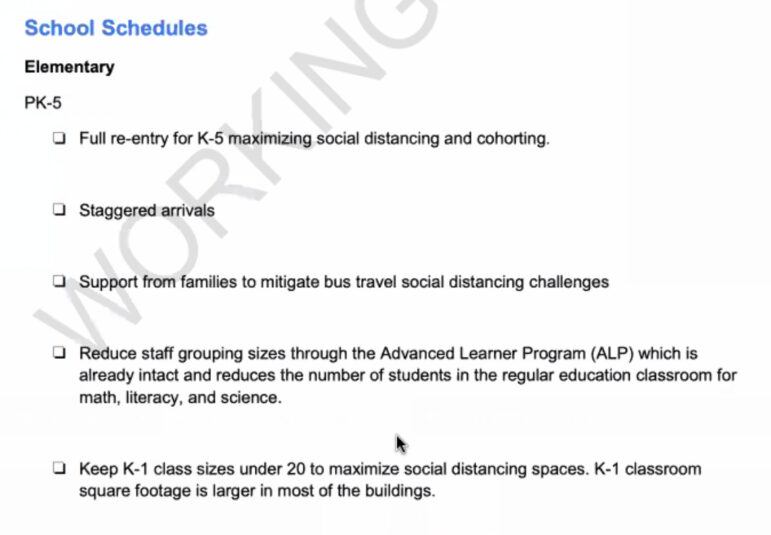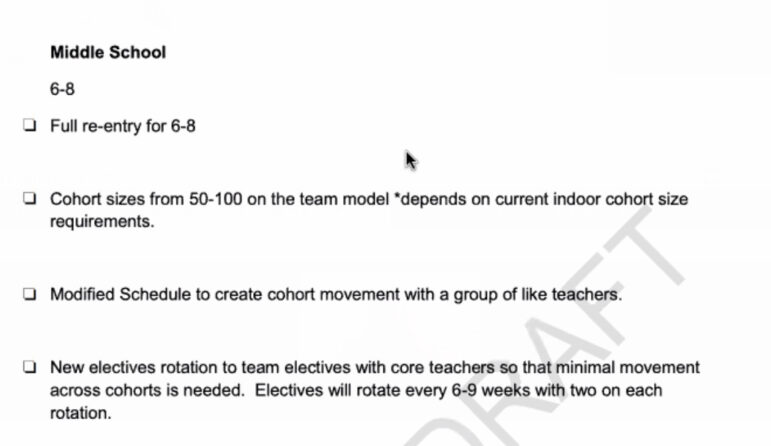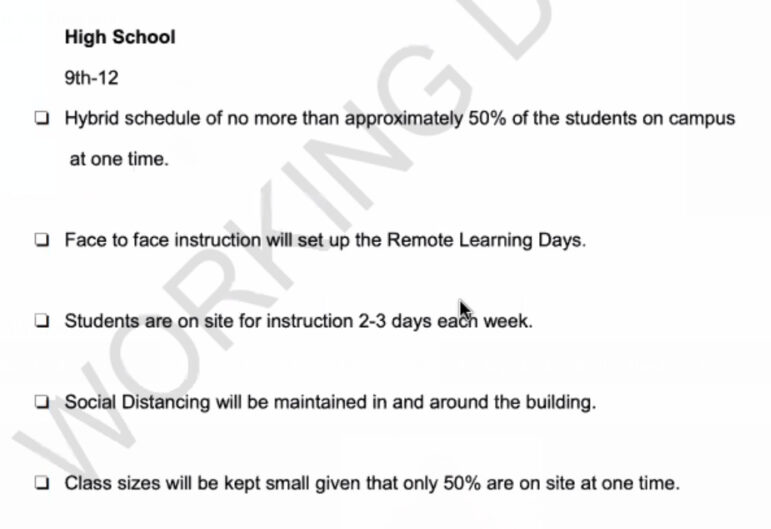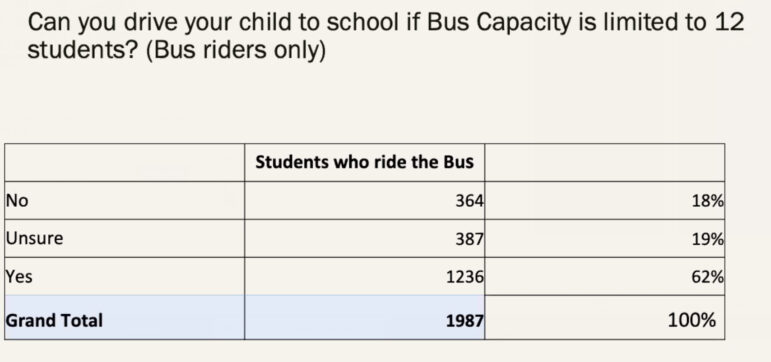Greenwich Public Schools administration is building a plan for 9,000 students to return to school in the fall with a choice of in-school or remote learning as required by the State of Connecticut.
An image of what school will look like began to take shape during a special BOE meeting Monday night that at one point was attended by 364 people.
The district is required to turn in a plan to the State including three scenarios: full return to school, hybrid return, and full distance learning, depending on whether there is low transmission risk, moderate or critical.
The plan was described as a flexible framework.
“The world is shifting under our feet,” said BOE chair Peter Bernstein, who said CDC guidance and State mandates could change between now and Labor Day.
Superintendent Dr. Toni Jones said schedules, particularly at GHS, need more work.
She said right now the district is looking at full entry for K-5 and trying to keep groups no larger than 20.
“We are trying to maximize social distancing, cohorting and staggered arrivals, and using different doors for students to enter through different spots,” she said.
“This is a change for us,” she said. “We have utilized one, two or three points of entry for safety and security. Covid is requiring a different viewpoint – monitoring more doors and having multiple points of entry, and entry where they’ll go straight to their classroom.”

The district is also planning for full re-entry in the three middle schools, with sizes of cohort groups between 50-100 students, but will reflect guidance from the State. Movement inside the buildings would be minimized.


For Greenwich High School, the district is considering dividing students in half and having one group come to school on Monday and Tuesday. Wednesday would be a deep cleaning day. The other half of students would come to school on Thursday and Friday.
Students will all be required by law to wear masks, including on the school bus, unless they get a medical waiver.
There will be “mask breaks,” but students otherwise will be required to cover their mouths and noses with masks on the bus and in school.
Dr. Jones said if students fail to comply, there will be consequences.
“We have to treat it as though a student is being non-compliant, just like if they don’t put their cell phone away – what does your discipline policy say?” Jones said. “It will be handled like any other compliance, because we have to by law, otherwise we open ourselves up to liability.”
Hallways will have directional lines on the floor to follow.
Student desks will be spread apart. Dr. Jones said the guidance is 6 ft separation “when feasible.”
Desks will be organized so that students don’t face each other. There will be hand sanitizer in all classrooms and they will minimize high touch materials such as art supplies.
In classrooms, there will be floor guidance mapping similar to that in grocery stores, mapping for rest rooms, plexiglass dividers in offices for essential face-to-face service, as well as a 6 ft teacher zone at the front of each room.
Water fountains will be open, but people will be discouraged from using them. Tissue grabs will be available outside rest rooms and there will be a switch over to no-touch paper towel dispensers in the bathrooms.
Children will be allowed to remove masks when they go outside for recess, for example, but they will have to store their masks carefully, but not in plastic.
The GHS gyms and Performing Arts Center will only be rented with a fee to pay for deep cleaning.
ACT and SAT testing are considered critical needs. Facilities would still be utilized for testing; cleaning would be planned for.
Visitors and volunteers will be limited to those considered “essential.”
Dr. Jones said that every Friday Fairfield County schools superintendents meet to compare notes, and that GHS is most similar to Danbury High School, which has a high school enrollment of 3,000.
The word of the night was cohorts.
“It’s really about keeping small groups of students and teachers together so there is less risk around the building that you’re coming in contact with someone who has Covid,” she said.
State guidelines for cohort groups are 50 for indoor, but, Jones said, by September it could rise to 150 depending on changes to public health data in coming weeks.
Cohorting is obviously easier in the younger grades than in middle schools and at Greenwich High School, where social distancing is a challenge and students change typically change for classes througout th eday.
Also, at GHS, students take a mix of grade level, honors and AP classes. This will create a challenge in building a cohort system.
Dr. Jones said PPE will be expensive and though the district has a good supply on hand, there will be another order before fall.
She said right before summer school the district expected a PPE shipment, but it was redirected. She noted that 39 states are spiking in Covid cases, and that scenario might repeat.
“If Connecticut is not spiking, they might not ship to Connecticut,” she said.
Additional staff will also be expensive. For example, 13 temporary non certified staff to disinfect and provide food service to classrooms breaks down to $20/hour for 6 hours, or $1,560 per day for a total of $280,000 for 180 school days.
Also, 3.0 full time certified temporary staff for cohorting will cost $75,000 each for $225,000 for the year.
Parents will have the choice of whether to send their children to school or keep them home for remote learning, but board member Christina Downey asked what would happen if families change their minds?
Dr. Jones said students can, by law, come in and out of in-person school.
But, she said, “If they opt out, more than likely it will take a two week period before they can opt back in.”
“What we cannot do is have parents and students changing their mind every other day,” she said. “Not only from an instructional standpoint, but from a safety standpoint. Keeping up with attendance at high school. It’s one thing when we’re not on Covid, when the 17 year old doesn’t show up and we’re trying to make sure they didn’t hop on a train to go meet someone they met on the internet, or (making sure) they didn’t have a wreck on their way to high school.”
“The school system has to be prepared to shut on a moment’s notice,” BOE member Peter Sherr said. “All the way from a classroom level down to the whole system, and it has to be prepared to keep going with education, whether in the classroom or at home.”
“We have to nail it on how to deliver education that way,” Mr. Sherr said of remote learning. “It has to have the goal of delivering direct instructions to students for core subjects…math, English, history/social sciences, science and language…If we’re not doing that, then kids are sliding….Time is not our friend here.
Dr. Jones talked about to creating “two schools” – one for remote learning and one in-person, which she said reflected the direction Greenwich received from the State.
Using second grade as an example, she said, “You couldn’t have a little second grader just sitting on the screen all day looking at the classroom. There is not a lot of engagement when you’re streaming, and you have a second grade teacher engaging with the kids who are physically there. …Literally, we create another school. …Otherwise, if you have 22 second graders who are distance learning, they’d be logging in to 22 different places at different schools.”

Dr. Jones talked about school bus service, and how mask wearing would be mandatory even before the student boards a Greenwich Schools bus.
Greenwich’s school buses are normally full, but State guidance is for a maxmum of 12 passengers.
Students would sit together with their siblings. Seats would fill starting from the back of the bus, as opposed to older students sitting in the back, and younger ones at the front, which is typical.
Students would exit the bus beginning with students at the front.
Importantly, to keep the number of passengers to 12, the district would ask parents to drive their students to school themselves, and the survey results indicated 62% of parents who responded could drive their children to school.
“We’re hoping that enough parents will drive their students so that the bus is not so full,” Jones said.
Kathleen Stowe said parents need to educate their children that mask wearing is the new normal.
She said her son plays summer baseball and that not only are parents kept at a distance from the field, but the children have been agreeable to comply with mask wearing when their choice is to play or not to play. She said she expects students will adopt mask wearing if it means they can return to school.
“If those are their options, they’re going to do it,” she said.
Lunchtime would look different as well. To keep cohorts together, students would eat in the classroom. Food would be brought to them, and it wouldn’t be the same cafeteria food they’re used to, especially in elementary school.
“Even when you talk about bag lunches, we know right now it depends on where kids are eating. In elementary school lunches have to stay pretty simplistic. We can’t take lasagna and be eating that in the classroom because we’d probably have a rodent infestation. One of the challenges with the youngest learners is they drop a lot of food. The level of cleaning when you eat in the classroom requires a different thought process.”
She said protocols will differ for each school building.
Students who opt for remote learning still are entitled to school lunches and families can pick up a daily breakfast and a lunch from locations across town between 11:30am and noon.
Dr. Jones said there are some family situations where transportation has been an issue. One example was a high schooler looking after four younger siblings while parents are at work. She said in that situation and some others with unique circumstances food has been delivered directly to the home.
Jones was asked if there will there be fall competitive sports.
She said the CIAC will make the determination, and that this month they allowed conditioning groups of no more than 10 to get started. However, she said one or two groups had to shut down after a positive case was identified. She said CIAC is considering having a season without spectators.
“They did consult major organizations about flipping seasons and having lower risk sports in the fall and the advisement they received was to start planning for the regular season. It could all change a week before school starts,” Jones said.
Dr. Jones was asked how students opting for distance learning could participate in clubs and activities.
“We’re going to do our very best to offer a great remote program, but it’ is going to look different for families who chose that option versus those who are on site,” she said. “What we can’t do is take someone doing remote learning and bring them back into the cohorts.”
Parents were surveyed at the end of the school year about their experience in remote learning and Dr. Jones said they kept the survey up for several weeks. A total of 1,566 participated. Respondents indicated that remote learning was most difficult for pre-K.
Summer school is under way, and compared to distance learning last spring, Jones and board members agreed there is significant live content, though BOE member Karen Kowalski said she’d like to see even more.
“A longer day would be helpful to provide more educational content,” she said. “But the live component has been very helpful.”
Summer school is considered a pilot for this fall. BOE chair Peter Bernstein said his child is attending summer school.
“Live instruction is working. It’s happening every day,” Bernstein said. “There is additional work after the class, homework, IXL, and other resources available for students. It’s worked quite well and I’m glad you’re using it as a pilot.”
Bernstein said he’d received feedback on remote learning. “I’ve heard loud and clear – more live, more scheduled, more structure.”
Ms Stowe, who has children in summer school, attested that distance learning had improved this summer. “The pilot is working,” she said.
Marc D’Amico, who recently moved from Glenville school principal to Director of Curriculum for K-8 and Head of K-5 Leadership for the district said focus groups had been helpful to reveal what was successful and what was not successful with remote learning.
He said the district’s technology was robust enough to carry live streaming simultaneously throughout all the schools.
“The remote learning school is fascinating. We’re building a brand new school we never had before,” D’Amico said. “That fact that you might have a teacher teaching students from 11 different elementary schools is certainly something we’ll have to work through the challenges for.”
Peter Sherr said remote learning is important because of the chance the entire district would have to revert to that model in the event of a spike in Covid.
“If we have to go back to distance learning and it doesn’t go well, there’s going to be hell to pay,” Sherr said.
Karen Hirsh, the board’s representative in the back to school task force, which meets twice a week, said the group is anticipating additional details from the State in several areas including class size, cohorting requirements, and mask breaks.
“When you look at class size and cohorting, I don’t think we’re going to get much more guidance than we have now,” Jones said. “Maybe from the Health Department. (Now) the guidance is ‘bring them all back; do the best that you can.'”
Ms Hirsh mentioned the idea of ‘learning cottages,” or trailers, had come up in their committee.
Dr. Jones said trailers might cost $20 an $30 million.
“When we just had $3 million cut from our budget. Is that really ok?” Jones asked of the expense to rent trailers. “When we look at PPE and what we know we have to do, when we start to look at adding in different facilities the cost would be extremely high.”
Peter Bernstein recalled the unpleasant years Hamilton Avenue students were in modulars.
Kathleen Stowe asked if off-site locations had been explored. Dr. Jones said she had spoken with Bobby Walker who was until recently the head of the Boys & Girls Club about using space there, and there was also consideration of renting a closed private school to house incoming GHS freshmen.
She said it would expensive to rent the empty private school at about $2.5Million, and the space could only accommodate about 400 students, while the income freshmen class has about 700 students.
“People may be sitting out there thinking, ‘I know exactly where 700 students can go.’ We’d love to hear from you if that’s the case,” Jones said.
Mr. Sherr suggested the board schedule a public hearing on school reopening, likening it in terms of importance to school start time and racial balance.
Mr. Bernstein pointed out the board had already received 6,500 individual responses from the community.
The next BOE special meeting is on Thursday, July 16, 2020 at 7:00pm on Zoom.